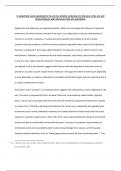Is subjectivity overly celebrated in the arts but unfairly condemned in reference to the arts and
history? Discuss with reference to the arts and history.
Subjectivity and objectivity are opposing qualities. While one encourages the influence of personal
sentiments, the other embraces freedom from bias. In art subjectivity is not just celebrated but is
intrinsic to an artist’s creativity. It is presented as the quality which allows an artist to evoke
emotions from the audience, and this emotional response arguably makes a piece of art significant.
However, as explored in this essay, subjectivity bears consequences such as; ethical concerns and
reductionism. Therefore, as evidenced by real-world examples, subjectivity can be overly celebrated
in the arts, thus I agree with this statement. However, in History, the same standard of subjectivity is
not applied. In fact, this question suggests that History should be objective as historians strive to
provide an accurate account of past events. However, I will argue the extent to which pure objectivity
is even attainable, as I believe subjectivity is inevitable and therefore agree with the statement that it
is unfairly condemned in history.
Tracy Emin’s work “my bed”, is an example which suggests that subjectivity is overly celebrated in the
arts. This work is composed of Emin’s unmade, filthy bed, surrounded by vodka bottles, cigarette
butts… hence, some may argue that this work lacks the technical, compositional elements to qualify
as a piece of art. Therefore, by being shortlisted for the Turner prize, subjectivity has arguably gone
to extremes and is overly celebrated. However, the context behind this work reveals that this piece
represents a period of depression in Emin’s life. Thus, upon understanding the intention and context
viewers are able to emotionally interact with this piece. It serves as a powerful representation of
emotional turmoil and vulnerability which evokes strong feelings from viewers- and this quality
complies with the definition of art as “being appreciated primarily for their emotional power” 1. This
1 Art, n.1 Meanings, Etymology and More | Oxford English Dictionary. https://www.oed.com/dictionary/art_n1?tab=meaning_and_use&tl=true.
Accessed 29 Nov. 2023.
, raises the question; if Emin’s work lacked context and intention- would it still exist as art? Therefore,
if subjectivity is inherent to art, it cannot be overly celebrated, and instead is justified.
However, by accepting subjectivity, individuals are able to devise their own criteria on which to judge
art, meaning that no piece of art can be acclaimed ,collectively, as a community- there will be no
standard of what constitutes a good piece of art. This idea of art, is extremely reductionist as it
reduces the technical craft of art into something dependent on the specific tastes of an individual.
This notion is flawed especially if considering David Hume’s standard of taste. Hume’s standard of
taste comments on the paradox between the assumption that taste is grounded in emotions and the
apparent fact that there can be a wrong and right appreciation of art 2. He ,therefore, developed a
criteria suggesting that some judgements are more valid than others, specifically the judgements
from a “true critic”. One of the 5 conditions Hume associates with being a “true critic” is “good
sense”, referring to the intellectual ability to understand an object’s design. Therefore, to embrace
subjectivity, is to suggest that everyone has the capacity” to deem a piece of art as “good” or “bad”,
despite potentially lacking “good sense”. Hence, subjectivity can be overly celebrated.
When considering works by Richard Estes ,for example, from a purely objective perspective his works
are remarkable, considering the meticulousness and accuracy involved in painting something so
realistic. However, one may argue that despite the technical skill in these works, they are ultimately
just reproductions of pre-existing photos. It could be said that photorealistic art is akin to a
photocopy, and therefore lacks the creative elements inherent to art. By being reproductions of a
photo, they arguably lack intention. Compared to Emin’s “My bed”, some may argue that with this
lack of artistic intention, these photos fail to be emotionally evocative- thus, suggesting that
subjectivity is fundamental to Art and therefore is justly celebrated.
2
HARTMANN, Léna. ‘Hume and the Standard of Taste’. Medium, 4 Apr. 2019, https://medium.com/@lena.hartmann/hume-and-the-standard-of-taste-e306bde7c726.




